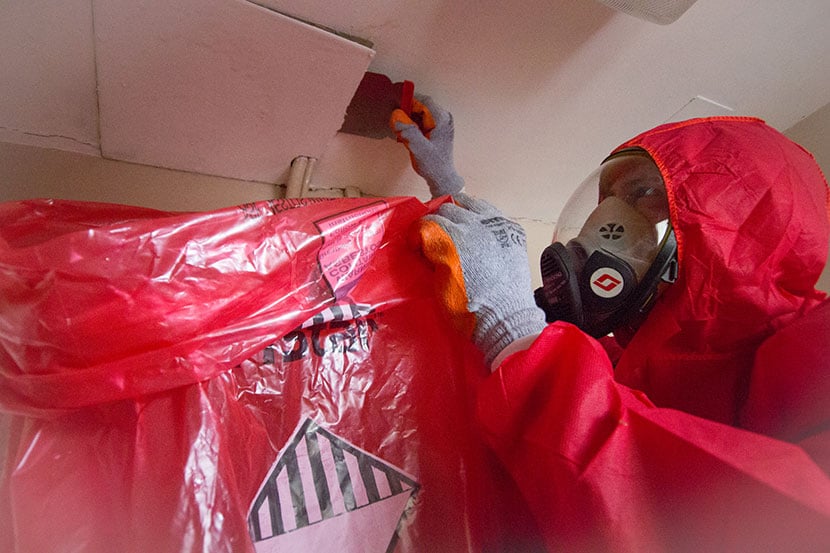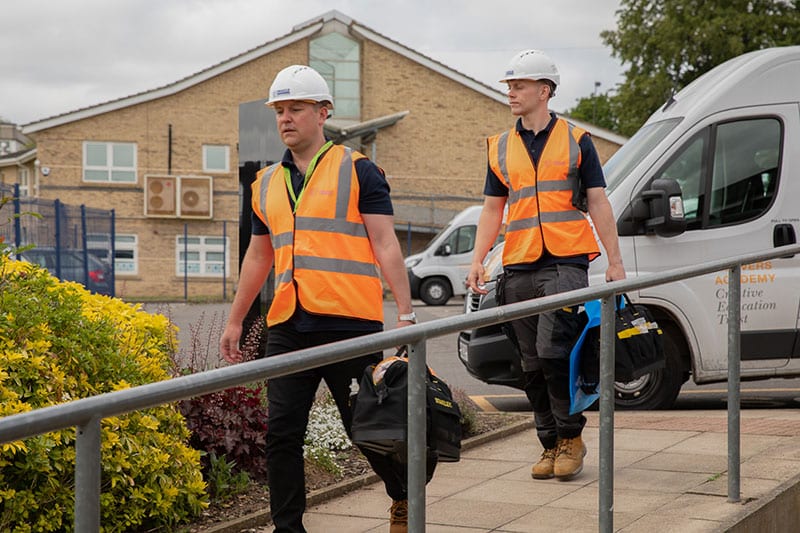What are some common myths and misconceptions about asbestos removal in the UK?
Understanding the truth about asbestos removal is crucial in order to protect your health and the health of others. It’s also a necessary component of staying legally compliant when dealing with asbestos. Additionally, for asbestos removal companies, running an effective, safe business is a must to maintain professional integrity.
Misconceptions about asbestos safety and compliance can lead to improper handling of asbestos-containing materials (ACMs). In turn, this can increase the health risks of people in the vicinity. Furthermore, when asbestos-related laws are violated, everything from reputational damage to hefty fines and even a prison sentence can be imposed.
In this article, we’ll go over some of the most prevalent myths and misconceptions surrounding asbestos in the UK.

Myth 1: Asbestos removal is always necessary
While ACMs that are damaged or disturbed can pose a serious health risk due to airborne asbestos fibres, it’s not true that removal is always necessary.
The appropriate action to take with ACMs depends on a variety of factors, including:
- The condition of the material
- How likely it is that the material will be damaged
- Where the ACM is located
Generally, ACMs that are in good condition and are not in danger of being disturbed don’t need to be removed.
When is asbestos removal necessary?
Asbestos removal may be necessary under some or all of the following conditions:
- The asbestos is damaged or deteriorating.
- The asbestos is friable, meaning it can be easily crumbled.
- Planned work on the building will damage ACMs.
- The ACM is in a high-traffic area where there’s a good chance it will be disturbed.
In other instances, encapsulation may be the better option.
When is asbestos encapsulation the better choice?
Alternative types of asbestos management may be a better option in the following scenarios:
- The ACM is in good condition.
- It’s unlikely that the ACM will be disturbed.
- Enclosing or sealing the ACM is possible.
- The ACM is in a low-traffic area.
It’s important to note that even if encapsulation is currently the better option, the ACMs must be monitored regularly. If they become damaged, a different approach will be necessary.
What types of asbestos management are necessary?
The duty holder of the building should conduct regular visual inspections to see if the condition of the ACMs has changed. If you’re uncertain of what you find, it’s best to hire a specialist to conduct a professional inspection.
Additionally, every commercial building should have an asbestos management plan. This will include steps for asbestos monitoring and maintenance. It will also outline what to do in the event that an ACM becomes damaged and requires removal.
Myth 2: Asbestos removal is a DIY job
It’s never recommended to remove asbestos unless you’re an expert. Without the proper training, it’s far too easy to cause an asbestos exposure event. This can put you and others in danger of inhaling toxic fibres.
Furthermore, trying to fix an unexpected exposure situation is far more difficult than removing ACMs the correct way. You may not know what to do if an accident occurs.
While there are certain types of low-risk asbestos work that non-professionals are legally allowed to handle on their own, you still need proper training to ensure the safety of others and the environment.
Myth 3: All asbestos is the same
There are several different types of asbestos and ACMs, and the risk level will vary according to certain properties.
For example, white asbestos is the most common type found in construction materials, but the shape of the asbestos fibres is less likely to get stuck in a person’s lungs. (Note that this doesn’t make this type of asbestos safe.)
Blue asbestos, on the other hand, is found in fewer construction materials than white asbestos. However, the shape of its needles makes it more dangerous, as the fibres can more easily lodge in lung tissue.
The term “friability” is often used when discussing asbestos risk factors. The more friable the material, the more easily it can crumble, making it particularly dangerous when this type of asbestos is disturbed.
Myth 4: Asbestos removal is extremely expensive
While asbestos removal can be costly, there are several factors that affect the cost, including:
- The type of asbestos to be removed
- The condition of the ACMs
- Where the ACMs are located
- How long asbestos contamination has occurred
- What’s required to stay compliant, such as permits
It’s important to understand that neglecting an asbestos issue now can result in added costs in the future. As ACMs deteriorate over time and infect the air with toxic fibres, the more difficult removal and air testing become.
Additionally, businesses could be fined for non-compliance. It’s also possible that businesses will lose income due to the reputational damage that can occur from improper asbestos management.
Myth 5: Asbestos removal can be done quickly
In general, asbestos removal is not a fast process. There are several steps that need to be taken to ensure safety and compliance, including:
- Assessment, inspection and testing
- Planning the removal project
- Obtaining permits
- Getting containment areas set up
- Removal and disposal of ACMs
- Post-removal cleanup
- Air quality testing
It’s also important for the removal work to be coordinated with other events in the building. For example, a school that requires asbestos removal may need to wait until summer break for the work to take place.
Myth 6: Asbestos only poses a risk during removal
The need for asbestos removal comes from an ACM posing a risk in its current state. While asbestos removal has the potential to damage an ACM, the biggest risk is not having a dangerous ACM removed.
Asbestos materials pose a risk when they’re damaged or deteriorate to the point where they release asbestos fibres. Those fibres are impossible to detect and can be easily inhaled or ingested. Once the fibres adhere to the lungs, they’re nearly impossible to remove. This can lead to life-threatening cancers and other diseases in the future.
Myth 7: Asbestos removal guarantees complete safety
While asbestos removal does reduce the risks of asbestos exposure significantly, it doesn’t necessary eliminate every single asbestos-related risk.
For example, even after professional asbestos removal, it’s possible that some residual fibres will remain in the air and on surfaces. While the removal company should thoroughly clean the work area and conduct air testing to eliminate all the fibres, many services don’t follow the proper precautions.
Additionally, some removal jobs also require certain ACMs to be encapsulated. In this case, the duty holder will need to regularly monitor the material for changes in its condition.
Myth 8: Asbestos removal can be done without special equipment
There’s an assortment of specialised equipment required for the proper removal, disposal and sanitation of asbestos:
- Personal protective equipment (PPE), including respiratory protective equipment (RPE), disposable clothing, boot covers, etc.
- Containment and ventilation equipment, including HEPA vacuums and air-monitoring devices
- Hand tools, wet sprayers and encapsulation materials
- Decontamination units and waste disposal bags
- Warning signs and barriers to prevent access to the work area
- Emergency equipment, including eyewash stations and first aid kits
While these items are important for following best practices, many of them are necessary for staying legally compliant, too.
Myth 9: Once asbestos is removed, no further action is needed
Removing ACMs can leave behind a lot of asbestos waste on surfaces and in the air. Post-removal, several steps must be taken, including:
- Thorough cleanup, including vacuuming and wet-wiping
- Disposing of all contaminated materials
- Air monitoring and clearance air testing
- Visual inspection that follows a comprehensive checklist
- Equipment and worker decontamination
- Documentation to maintain up-to-date records
- Issuance of a completion certification
- Approval for reoccupation
- Ongoing inspections and adherence to a maintenance plan
Only when all of these steps are taken can a duty holder ensure the safety of building occupants and compliance with the law.
Myth 10: All contractors are qualified to remove asbestos
Not all contractors in the UK are proficient enough or legally able to remove asbestos. It’s important to check the contractor’s credentials to verify that they have the experience and licensing necessary for the job at hand.
In order to carry out licensable work with asbestos, Health and Safety Executive guidelines must be met. Additionally, the contractor should have received the proper training and certification from UKATA.
It’s also important that the contractor has liability insurance that specifically covers asbestos work.
Final thoughts about asbestos removal myths in the UK
It’s of critical importance to debunk the myths about asbestos removal in the UK. Misconceptions and misleading information can increase health risks, lower safety precautions and lead to compliance issues.
By educating professionals and the public about proper asbestos management, accurate information will spread and safeguard everyone’s health. It’s important that commercial and residential environments remain safe for occupants and visitors.
Whenever necessary, seek out professional advice and training. Asbestos is incredibly dangerous, and the topic should never be taken lightly.
To speak with an asbestos expert or discuss asbestos removal services, contact Oracle Solutions today.

Written by Callum McDonald
Callum McDonald is an expert in asbestos quality management, ensuring rigorous adherence to regulations and high-quality standards in removal projects. His focus on enhancing quality and client satisfaction makes him a crucial asset in safety and compliance within the field. Callum's expertise in technical support and oversight of licensed works underscores his commitment to excellence in asbestos management, providing invaluable guidance to clients in this specialised area.

